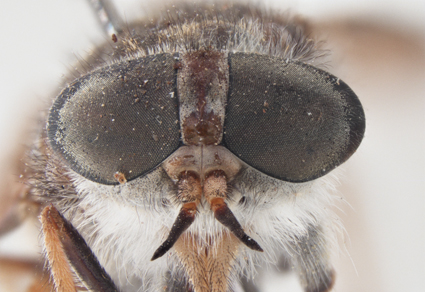Abstract
Two new horse fly species, Dasybasis mancoi sp. nov. and D. huaynai sp. nov. (Diptera: Tabanidae: Diachlorini), are described from the Peruvian Andes near Cusco on the basis of morphological features, including those of the female genitalia. Digital photographs of both species and of the terminalia of both females and of one male are provided. The two new species are related to D. bulbula Coscarón & Philip, as evidenced by their similar morphological characteristics.
References
- Baldacchino, F., Desquesnes, M., Mihok, S., Foil, L.D., Duvallet, G. & Jittapalapong, S. (2014) Tabanids: neglected subjects of research, but important vectors of disease agents! Infection, Genetics and Evolution, 28, 596–615. https://doi.org/10.1016/j.meegid.2014.03.029
- Brèthes, J. (1920) Insectes du Perou. Anales de la Sociedad Científica Argentina, 89, 26–54.
- Carrasco, F. (1972) Tábanos de1 Perú. Revista Peruana de Entomología, 15 (2), 317–323.
- Coscarón, S. & Papavero, N. (2009) Catalogue of Neotropical Diptera. Tabanidae. Neotropical Diptera, 16, 1–199.
- Coscarón, S. & Philip, C.B. (1967) Revisión del género “Dasybasis” Macquart en la región Neotropical (Diptera: Tabanidae). Revista del Museo Argentino de Ciencias Naturales Bernardino Rivadavia, Entomología, 2 (2), 15–266.
- Cumming, J.M. & Wood, D.M. (2017) Adult morphology and terminology. In: Kirk-Spriggs, A.H. & Sinclair, B.J. (Eds.), Manual of Afrotropical Diptera. Volume 1. Introductory chapters and keys to Diptera families. Suricata 4. South African National Biodiversity Institute, Pretoria, pp. 89–133.
- Fairchild, G.B. (1964) A new genus and species of Neotropical horsefly (Diptera: Tabanidae). Psyche, 70 (4), 193–196. https://doi.org/10.1155/1963/47356
- Fairchild, G.B. (1972) A new species of Querbetia (Diptera: Tabanidae) from Peru. Psyche, 79 (3), 213–214. https://doi.org/10.1155/1972/90764
- González, C.R. (1999) A revision of the southern Neotropical genera related to Dasybasis Macquart, 1847 (Diptera: Tabanidae: Diachlorini). Contributions to the Knowledge of Diptera. Memoirs of the American Entomological Institute, 14, 137–194.
- Goodwin, J.T. (1999) Dicladocera fairchildi, a new species of Tabanidae (Diptera) from Peru. Contributions to the Knowledge of Diptera. Memoirs of the American Entomological Institute, 14, 135–136.
- Henriques, A.L. & Krolow, T.K. (2020) Tabanidae (Diptera) of Peru: Checklist update and three new species description. Revista peruana de biología, 27 (4), 429–440. https://doi.org/10.15381/rpb.v27i4.19196
- Henriques, A.L., Krolow, T.K. & Rafael, J.A. (2012) Corrections and additions to Catalogue of Neotropical Diptera (Tabanidae) of Coscaroìn & Papavero (2009). Revista Brasileira de Entomologia, 56 (3), 277–280. https://doi.org/10.1590/S0085-56262012005000042
- Philip, C.B. (1960) Further records of Neotropical Tabanidae (Diptera) mostly from Peru. Proceedings of the California Academy of Sciences, 31 (3), 69–102.
- Philip, C.B. (1961) Additional records of Tabanidae from the west coast of South America. The Pan-Pacific Entomologist, 37 (2), 111–116.
- Philip, C.B. (1969) New or little-known Neotropical Tabanidae. The Pan-Pacific Entomologist, 45, 147–152.
- Soukup, J. (1945) Lista de los dípteros peruanos descritos en los últimos años. Boletín del Museo de Historia Natural Javier Prado, Lima, 9 (32–33), 119–142.
- Wilkerson, R.C. & Fairchild, G.B. (1984) A Checklist and Generic Key to the Tabanidae (Diptera) of Peru with Special Reference to the Tambopata Reserved Zone, Madre de Dios. Revista Peruana de Entomología, 27 (1), 37–53.


